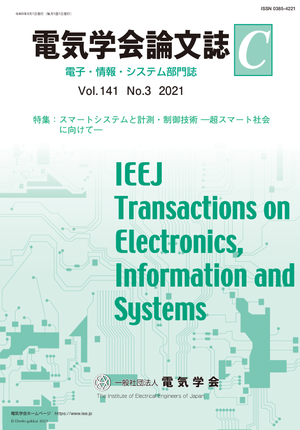Purchasing Behavior Prediction Model for Real Stores Considering Product Cluster and Time-series Patterns
Purchasing Behavior Prediction Model for Real Stores Considering Product Cluster and Time-series Patterns
カテゴリ: 論文誌(論文単位)
グループ名: 【C】電子・情報・システム部門
発行日: 2021/03/01
タイトル(英語): Purchasing Behavior Prediction Model for Real Stores Considering Product Cluster and Time-series Patterns
著者名: Yuiko Sakuma (Graduate School of Science and Technology, Keio University), Masahiro Yoshida (Graduate School of Science and Technology, Keio University), Hiroaki Nishi (Department of System Design, Faculty of Science and Technology, Keio University)
著者名(英語): Yuiko Sakuma (Graduate School of Science and Technology, Keio University), Masahiro Yoshida (Graduate School of Science and Technology, Keio University), Hiroaki Nishi (Department of System Design, Faculty of Science and Technology, Keio University)
キーワード: purchasing behavior prediction,time-series modeling,recommender system
要約(英語): Recently, cashless payment services have been rapidly introduced, increasing the demand for recommender systems for real stores. Recommender systems have been well-studied and successful in many Internet services. While factors such as the diversity and coverage of products should be considered, the prediction accuracy of user purchasing behaviors is the most crucial factor in a recommender system. This research proposes a purchasing behavior prediction model for real stores by using purchase history data collected from a supermarket in Saitama City, Japan, as a part of a smart city project. Time-series patterns in purchasing behavior indicate the sales characteristics of supermarkets, where daily products are predominately purchased. For example, some users repeatedly purchase specific products in a certain period or purchase different products from their previous visit. Many previous studies have only considered the compatibility between the features of users and items; however, this work also models the time-series patterns of purchasing behavior. The proposed prediction model adopts ensemble learning, in which weak learners learn the two factors (the compatibility between users and items) and time-series patterns of purchasing behavior separately. Moreover, product names in supermarkets often contain meta-information of the product alongside the item name. For instance, the product name “three tomatoes from Gunma Prefecture” includes information about the quantity and manufacturer as well as the item name “tomato”. However, products that are the same item but have different product names are likely to be purchased together in the context of purchasing activity, thus deteriorating the prediction accuracy. Therefore, a product classification method is proposed to categorize the products for each item. The experimental results show 3.2% and 10.6% improvements in the precision-recall area under the curve (PR-AUC) for the proposed method compared to models that consider only the compatibility between users and items and the time-series patterns of purchasing behavior, respectively.
本誌: 電気学会論文誌C(電子・情報・システム部門誌) Vol.141 No.3 (2021) 特集:スマートシステムと計測・制御技術 -超スマート社会に向けて-
本誌掲載ページ: 471-482 p
原稿種別: 論文/英語
電子版へのリンク: https://www.jstage.jst.go.jp/article/ieejeiss/141/3/141_471/_article/-char/ja/
受取状況を読み込めませんでした


